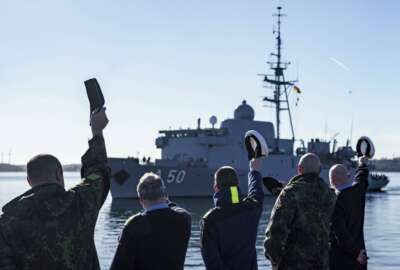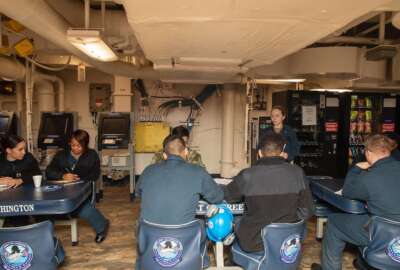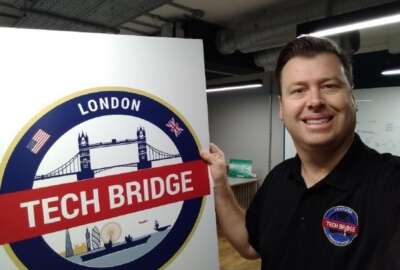Navy’s construction battalion celebrates eight decades of service
The Naval Construction Battalion Center (Seabees) is celebrating 80 years having been established June 2, 1942.
Best listening experience is on Chrome, Firefox or Safari. Subscribe to Federal Drive’s daily audio interviews on Apple Podcasts or PodcastOne.
The Navy builds lots of things that float, but it also needs ports, depots and other constructed facilities. The Naval Construction Battalion Center is celebrating 80 years having been established June 2, 1942. For the latest on the Seabees’ contemporary mission and activities, the Federal Drive with Tom Temin turned to its commander Capt. Jeff Powell.
Interview transcript:
Tom Temin: Capt. Powell, good to have you on.
Jeff Powell: Thanks, Tom. It’s great to be with you today.
Tom Temin: Well, let’s begin with the beginning. What exactly does the Seabees do at the Naval Construction Battalion Center?
Jeff Powell: So the Seabees were formed in World War II in 1942. There was a need for overseas construction, and that was being accomplished by civilian contractors. As the war progressed and enemy activity increased, they realize they cannot have civilians that were untrained. They want combatants out in these far flung reaches mostly in the Pacific. And so the idea was born that we needed kind of combat construction personnel. And so the original Seabees, and their numbers swelled to 350,000 or so during World War II, but the original Seabees were tradesmen. I mean, they weren’t not necessarily your 18-year-old recruits. They were some 30, 40, 50 years old at the time, and they came in at different rates and pay grades, and they put them in military formations. And their exploits during World War II were pivotal, certainly in the Pacific, but also across the European theaters.
Tom Temin: Right, they built runways and so forth.
Jeff Powell: They would go to an uninhabited island in the middle of Pacific and tear down the jungle and figure out how to get the rock and quarry and water and supplies. And they would build a runway and build a base and, I’m no aviation expert or ship expert, but our ships and our planes did not have the range that they do now. And so they needed these intermediate staging areas. They walk across the Pacific on their way to Japan and taking the fight to the enemy. So they needed a lot of bases back then. And then certainly, anytime you need expeditionary construction, quick construction, they call the Seabees. And that’s where the history and the legacy of the units were born.
Tom Temin: Now that’s less of a requirement in ordinary times nowadays. So what does the battalion do these days?
Jeff Powell: Over the years, as the Navy, the entire Department of Defense would swell up for World War II and then it would contract a little bit. We’d have, they called it peace dividend, right? Your ships are decommissioned and units are decommissioned. And then it would increase again for Korea and then it would contract again. So we have ebbed and flowed over the years. Currently there are six active duty battalions, and there are five reserve battalions. Just a few years ago, kind of the height of operations in Iraq and Afghanistan, there were 21 total battalions. There were nine active and 12 reserves. So even in recent history, in the last 10 or 15 years, we have contracted and gone back to this steady state of now about 11 battalions. They are still deploying and so we have three active battalions here at the base in Gulfport, Mississippi. There’s three active battalions in a base out west called Port Hueneme, California. And they deploy on a six month rotation headquartered in Rota, Spain, and our case here in Gulfport. And then from there, they fanned out to all over Europe, Africa and even some of them go to the Pacific. And they are doing peacetime construction. They’re doing training, they’re doing partner kind of nation building, and their afforded presence, like a ship or any other military asset overseas ready to respond to anything that may be called upon. But they’re doing all kinds of construction. And certainly, nowadays, the specialty and the focus is going to be on airfield damage repair, port damage repair, again, when and if we need to, for a contingency getting an airfield and port facilities up and running so that our planes and our ships or submarines can refuel and resupply.
Tom Temin: I guess it’s overlooked sometimes, the fact that the Navy does need airfields because planes from carriers don’t live their entire lifecycle just on a carrier.
Jeff Powell: Correct. No, of course, I’m a little biased but I think the Navy obviously goes from space to air to surface to below surface and in my world, people for years have asked me after 27 years in the Navy, what ships have I been on? I’ve never been on a ship. I am a dirt sailor. So there’s certainly a land component to the Navy and there’s certainly need for facilities ashore. And that’s where the Seabees come in, primarily in overseas and contingency and hostile environments.
Tom Temin: We’re speaking with Capt. Jeff Powell. He’s commander of the Naval Construction Battalion Center – Seabees – now celebrating its 80th anniversary. So just to make sure we understand for U.S.-based facilities that need modernizing and construction, that’s not the Seabees. That’s contractors the Navy hires, otherwise?
Jeff Powell: That is correct. So Seabees might do some small projects here and there. So I mentioned their six-month deployment, they’re then home for 12 months, and that’s kind of the 18-month cycle. So while they’re home for 12 months, they might do small projects on this base, or on another base to train. But it’s a lot of classes, they’re doing weapons proficiency, they’re doing military tactics, they’re taking different specialized construction classes. They’re not necessarily building things on this base. A lot of the projects we’re doing are pretty complex. There’s lots of environmental considerations and mechanical, electrical and computer systems that have to go into a lot of our facilities now. And so those are contracted out to civilian contractors. Different tours that I’ve been in I’ve managed those kinds of projects as well. But the Seabees are kind of fast expeditionary construction, not necessarily the finished permanent facilities that we would occupy in the United States and on a military base.
Tom Temin: Yes. So what kind of talent do you need to fill out the Seabees? And what specific types of work do they do? I mean, the old pictures show people smearing concrete and digging and that kind of thing. Do they still do that kind of thing? And what kind of talent do you need?
Jeff Powell: Across the Navy, there is different ratings, right, there’s medical corpsman, and there’s air traffic controllers, and there’s engine men on ships. Well the Seabees has seven different ratings. There are builders and steel workers, electricians, utilities, men who are plumbers, engineering aides or surveyors, drafters, equipment operators, and construction mechanics. So we have tons of construction equipment, generators and all kinds of things that need to be maintained. So that’s the equipment operators. We have a training program, lots of mobile cranes. So equipment operators, mechanics keep equipment running. They also will do some, what we call horizontal construction. So they’ll do the dirt work and earthwork and digging and berms and grading and road construction. And that’s where the runways and things come in. And then we have our utilities folks which are electricians and plumbers, connecting generators, building expeditionary restroom facilities, laundry facilities, things like that. And also they can wire a house or wire an operations center if we’re building an expeditionary kind of a hut to be an operation center, they can put plumbing and power in there if they need to. And then we have your typical builder – what they’re doing – masonry, carpentry, woodworking, any kind of construction. And then we have engineering aids, which are surveyors and they’re doing the testing and some of the planning and the drawing and the drafting for those. So it all comes together in a team. You mentioned concrete, on a concrete day though, maybe every Seabee is out there, helping place the concrete because that’s kind of an all-hands-on-deck evolution. There’s definitely some what we call cross grading. You may be trained as an electrician, but you’re also gonna understand how to place concrete or maybe you have to get into a piece of equipment and operate it. So that’s kind of where the Seabees are fairly legendary for their creativity and their teamwork and their can-do spirit.
Tom Temin: Well that takes the operation of a whirlybird when you’re done with the concrete roughed in. And so what I’m driving at is that it sounds like a great Naval career that could lead to a fantastic civilian career, because those jobs are in demand, they pay well, and anyone that’s ever seen the controls of a steam shovel or a crane knows that’s complex work.
Jeff Powell: Absolutely. And I will tell you, there’s lots of great jobs in the Navy, the Seabees are definitely ones that have applicability whenever that service members done serving, whether that’s their initial four-year stint, or whether you’re 20 or 30 years. The skills that they have are definitely in demand, project planning, they’ve done some deployments, they understand construction, they understand how to work together as a team, but they definitely have a tangible skill. And I’m not taking anything away from folks that are operating weapon systems on ships or submarines or things like that. But there’s not necessarily a civilian equivalent of that as direct as the Seabees have. So it’s definitely a neat part of the Navy that a lot of folks don’t know about. I should mention numbers, there’s about 9,000 active duty Seabees. And just for context, there’s about 330,000 active duty sailors in the Navy. So it’s something like 2% of the Navy is Seabees. It’s a pretty small thing. And the Navy has mostly ships and submarines and aviation. But we are there to support and move ashore when the Navy needs us to.
Tom Temin: And how are you celebrating the 80th anniversary?
Jeff Powell: Well so two big events this year: I mentioned 1942, and March 5 is actually the birthday, the Seabees celebrated their 80th anniversary as a force, as a part of the Navy. The base here in Gulfport, Mississippi, was also formed in 1942. And more specifically in June. But we had two big events already this year with some more highlights and celebrations to come later this year. But our big event was we have a Seabee ball every year. So there’s a Navy ball and the Army has a ball and the Marine Corps has a ball. The Seabees have their own ball, and it’s a great tradition. We get dressed up and we get some great remembrances and a good speaker and a good meal. And we did that in March. And then a better part of a month ago here we had what we call Seabee Day on the base, which is an open house, static displays of weapons and equipment and materials, and we had food vendors and live music and essentially our version of an air show for this base. It’s open to the public and we had about 4,000 to 5,000 people here. It’s something we do every couple of years and we happened to do this year with a theme built around the 80th anniversary of the base and how important it is to the community here in South Mississippi.
Tom Temin: And you said there’s some more coming up though.
Jeff Powell: We’ll just continue to have profiles and we’re getting some good public affairs products out there. And there’s some proclamations still coming from the city and some things like that that are gonna to celebrate the great relationship we have with the city of Gulfport, Mississippi.
Tom Temin: Yeah, probably a good chance to remind your congressional overseers too, and appropriators, “Hey, we’re here and look what we do.”
Jeff Powell: Right. It’s interesting, a lot of folks don’t know there’s Navy bases in Mississippi. There’s 70 bases in the Navy and we’re one of them, and we have an important mission. And I should just mention, we don’t just have Seabees here, we have other tenants. There’s about 40 tenants on this base. We provide some other services. They’re building ships in Pascagoula, Mississippi, and there’s also a huge Navy presence out at Stennis Space Center. We provide some services out there as well. So there’s a lot of military here and on the coast of Mississippi, and we’re the lone base down here providing a lot of the support and services to enable them to do their missions.
Tom Temin: And as commander, did you come up through the Seabees yourself and what was your particular skills?
Jeff Powell: I’m not prior enlisted, I went to Clemson University in South Carolina – Go Tigers – I’m sorry, I have to say that. And then I’ve done a variety of tours. So in our community as an officer community, we’re not always with the Seabees. I’m sometimes with just the short facilities I mentioned, managing civil and construction contracts or I’ve been the public works officer of a base. I’ve been to D.C. and worked at the Pentagon on the programming and budgeting side. Done lots of deployments and different things. I’ve had about five tours with the Seabees in different capacities as leadership capacities, but I don’t necessarily have a trade. I mean, my background, my degrees are in engineering. So that’s the leadership and oversight that I provide to the units as I’ve been with them.
Tom Temin: Well if you know your way around the [Planning, Programming, Budgeting, and Execution process], that’s kind of a trade in and of itself.
Jeff Powell: Oh, yes. I enjoyed D.C. It’s fantastic, good tour, in fact I counsel a lot of our mid-grade and junior officers that they have to get to D.C. to understand how the sausage is made and how the Navy and the nation works. And so it was a great tour, and I really enjoyed my time in the Pentagon. Hard to believe that but that is true.
Tom Temin: All right. Capt. Jeff Powell is commander of the Naval Construction Battalion Center, the Seabees, now celebrating its 80th anniversary. Thanks so much for joining me.
Jeff Powell: It’s great, Tom, great to talk to you and thanks for your time this morning.
Copyright © 2025 Federal News Network. All rights reserved. This website is not intended for users located within the European Economic Area.
Tom Temin is host of the Federal Drive and has been providing insight on federal technology and management issues for more than 30 years.
Follow @tteminWFED






